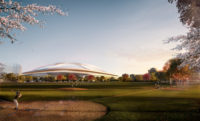In Tokyo, Protestors Don't Want 1964 Olympics Stadium Replaced by Zaha Hadid's








Architects & Firms
On Saturday, placard-wearing protestors took to the streets of central Tokyo and peacefully encircled the 50,000-seat Kasumigaoka National Stadium designed by Mitsuo Katayama and erected for the 1964 Olympics. In preparation for hosting the games again in 2020, the vintage structure is being readied for demolition followed by replacement with a futuristic, Zaha Hadid-designed arena several times its size. But a collection of architects and lay people alike are hoping to convince the Japan Sport Council (JSC) to do otherwise.
Japan does not have a great track record when it comes to preserving historic structures. Yet the destruction of a building that has come to symbolize the country’s revival after World War II is just one reason why some are up in arms over the proposed arena. The result of an international competition, the commission was awarded to the London-based designer before Tokyo had even been selected as the host city. Perhaps the building’s bold form—it resembles an enormous bike helmet—helped sway the International Olympic Committee (IOC). Or maybe it was the stadium’s location. Tokyo lost a previous bid when officials suggested a site in Odaiba, a newly developed area with plenty of open space but situated at the edge of Tokyo Bay, apart from the city’s core.
Reusing the old site within the Meiji Shrine Outer Gardens, a careful composition of green spaces and athletic facilities laced together with tree-lined streets, was clearly more desirable. Yet fitting the 3.1 million-square-foot structure on the existing stadium’s 1.2 million-square-foot site will require removing mature trees and existing nearby facilities. Not to mention the stadium’s 230-foot height will far exceed the precinct’s 65-foot limit. And due to the lack of open space, the giant building is likely to abut the street, resulting in a potentially unfriendly condition for pedestrians.
Shear bulk aside, the cost of the new construction is another cause of dissatisfaction. Given the daring design, it is difficult to put an exact price tag on the building but it is estimated to run as high as $1.7 billion dollars. There is also concern that a project of this magnitude will siphon off funding, labor, and construction materials still needed to resuscitate Tohoku from the triple disasters of 2011.
And then there is the utility and upkeep of an 80,000-seat stadium with a retractable roof—neither requirements of the IOC. After the games are over officials envision the building as the venue for rock concerts. Yet many question the need for such a large event space that will be used infrequently and burden taxpayers with its operation and maintenance costs, estimated to run at least $35 million yearly.
Protest efforts to date have had a modicum of success as the JSC agreed to scale back the stadium by 20 percent. But detractors maintain that it is still too big. Instead, a renovation of and an addition to the 1964 stadium would be cheaper and faster. Says architect-activist Edward Suzuki, “[The IOC] clearly stipulated that host countries try to use existing facilities where possible yet they are not abiding by this.”





